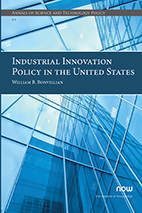Industrial Innovation Policy in the United States
By William B. Bonvillian, Massachusetts Institute of Technology, USA, bonvill@mit.edu
Abstract
Despite longstanding opposition from mainstream economists to industrial policy, in the period of 2020–2021 the United States, confronted by advanced technology competition from China, the demands of climate change, and the need to respond to a global pandemic, adopted a series of major industrial policy programs. Although the U.S. Defense Department has long practiced industrial policy approaches, and the U.S. has followed industrial economic policies in its agriculture, transportation, electric power and healthcare sectors, the new programs focused on promoting technology innovation, so can be labled “industrial innovation policy.” The large scale of these efforts amounted to a new step for the U.S. in non-defense sectors.
There is history behind this step. Contrasting Hamiltonian and Jacksonian economic views anticipated this industrial policy debate. While during World War II the U.S. entered into a highly connected set of industrial innovation policies, linking industry, universities and government for technologies like radar, electronics and nuclear energy, it departed from this approach in the immediate postwar. Vannevar Bush, the architect of postwar science organization, backed a linear model, combining federal support for basic research with a supposition that industry would manage the subsequent technology implementation. This position came under fire in the 1980s from critics like Donald Stokes as U.S. manufacturing declined with the rise of Japan’s quality manufacturing model, which was backed by government industrial coordination and support. Gradually, the U.S. began retreating from a basic research-only approach in non-defense areas through a series of policies. These included, in the 1980s a response to Japan’s quality manufacturing model, then starting in the 2000s a response to climate change through a reorganization of energy programs, and then after 2012 in response to China’s manufacturing advances the adoption of advanced manufacturing policies.
Although the definition of industrial policy is debated, with some arguing it should serve social needs versus specific technology advances, this study adopts a more straightforward definition. Industrial innovation policy involves governmental intervention in one or more of the post-research innovation stages, from development to prototyping to production, to further technology innovation. The study reviews in detail six major examples of new U.S. industrial innovation policies adopted between 2020 and 2022: Operation Warp Speed for coronavirus pandemic vaccines; the CHIPS Act to restore U.S. semiconductor leadership; the Infrastructure Act of 2021, with its major support for new energy technology development; the Inflation Reduction Act, with its impetus for implementation of new energy technologies; the Biden Administration’s Assuring Domestic Supply Chains initiative, and the Endless Frontier/CHIPS and Science Act, with its support for applied development of critical technologies and regional innovation. All adopt an industrial innovation policy approach.
These take different approaches. Operation Warp Speed, for example was more “top down,” with government selecting then supporting a series of companies to develop four different vaccine platforms. Tesla was an example of a “bottom up” approach, with government creating a range of technology incentives which companies – in this case Tesla – could systematically apply to electric vehicle development. However, there remain major gaps in U.S. industrial innovation efforts in scale-up financing, advanced manufacturing support and cross-agency coordination. The scale of China’s extensive industrial financing policies offers a useful comparison to U.S. scale up efforts. Overall, the study reviews in detail the need for the U.S. to adopt a new kind of infrastructure and accompanying operational mechanisms in order to make its new industrial innovation policies work. These include: rebuilding manufacturing foundations; testing and demonstration capability; mapping supply chains; technology certification; better integration between industries, universities and government; technology scale up support; application of government procurement; and use of flexible contracting mechanisms.
Industrial Innovation Policy in the United States
The U.S. government is pursuing a series of new industrial policies at a level not seen before. This effort has been driven politically on a bipartisan basis by concern over China’s extensive industrial policy system. Growing concern about climate change has also been a major driver for these new policies as has the Covid-19 pandemic.
Industrial Innovation Policy in the United States places these new policy approaches into an historical context, particularly emphasizing industrial policy approaches to the innovation system. It then reviews the definitional and economic debates over industrial policy. Next, it catalogs and summarizes the main thrusts of new U.S. industrial policy efforts and describes the major elements, as well as gaps in these approaches. In particular, it notes the critical gap in the U.S. for scale-up funding for moving new technologies into production as compared to China. The author also notes the types of industrial innovation policies, characterizing “top down” and “bottom up” approaches. Finally, the monograph reviews the new mechanisms and supporting infrastructure needed to make industrial policy approaches operational.
